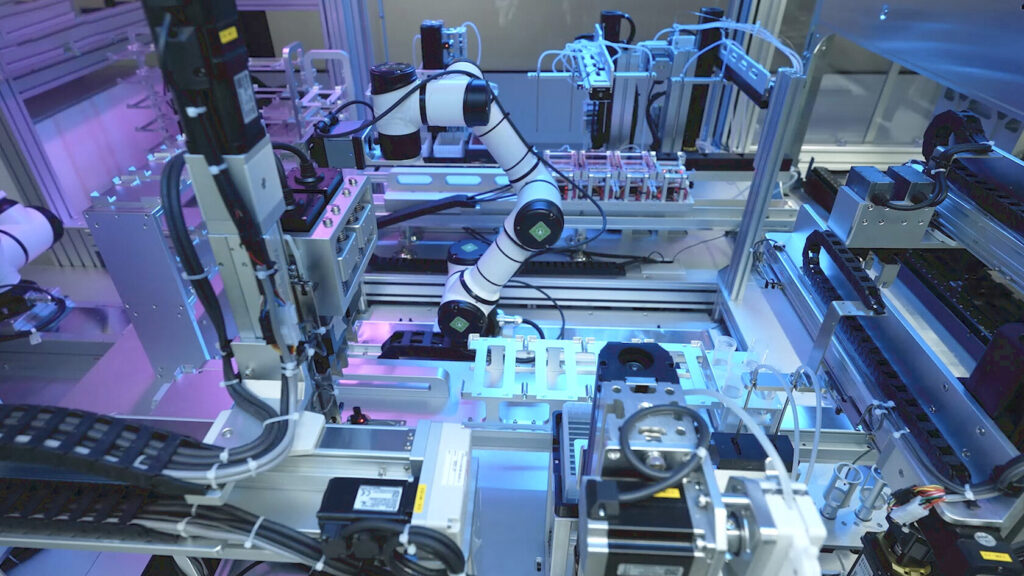Quantum computing and artificial intelligence (AI) can be combined with classical computing methods to design and discover small-molecule candidates that target the cancer-driving KRAS protein, researchers from AI drug developer Insilico Medicine and the University of Toronto have reported.
The researchers developed a generative AI model that designed new molecules by pairing a quantum computer with classical computing methods. The investigators then selected and synthesized 15 proposed molecules that showed they could inhibit KRAS. Two of the 15 molecules showed promise for future development as KRAS inhibiting cancer candidates.
“This study highlights the promising intersection of quantum computing and drug discovery, marking a quantum computer’s first experimental hit,” the researchers summarized in “Quantum-computing-enhanced algorithm unveils potential KRAS inhibitors,” a study published in Nature Biotechnology. “This synergistic approach could potentially lead to the discovery of therapeutics that might be overlooked by other methods, while also reducing the preclinical drug discovery phase from several years to just a few months.”
Alex Zhavoronkov, PhD, Insilico’s founder and CEO, told GEN Edge that while the study results showed the potential of quantum computing to accelerate the early stages of drug discovery, “they stop short of showing that the molecules discovered using this approach are more effective than molecules identified through classical methods.”
“We hope that as the capabilities of quantum computers increase, algorithms and results are expected to perform better and better,” Zhavoronkov said.
Insilico has explored incorporating quantum computers into AI-driven R&D processes for several years, with the aim of accelerating preclinical drug discovery. Zhavoronkov was a co-corresponding author of the first study exploring the quantum advantage in small molecule drug discovery, published in the Journal of Chemical Information and Modeling.
In that study, researchers reported how they substituted each part of MolGAN, an implicit generative adversarial network or “GAN” for small molecular graphs, with a variational quantum circuit (VQC) step by step including as the noise generator, generator with the patch method, and quantum discriminator. The circuit’s performance was compared with that of its classical counterpart.
“Well-documented challenges”
In the newly published study, Zhavoronkov and other researchers paired a quantum computer alongside classical computing methods to design new molecules against KRAS, which is present in about one in four human cancers, driving uncontrolled cell growth.
KRAS was long considered an undruggable protein due to its structural complexity with its shallow binding pockets and absence of clear, exploitable binding sites, as well as because of its high affinity for its natural ligands guanosine triphosphate (GTP) and guanosine diphosphate (GDP).
KRAS G12C mutations are the targets of two FDA-approved cancer therapies. One is Amgen’s Lumakras® (sotorasib) approved in 2021 for treating non-small cell lung cancer (NSCLC) and metastatic colorectal cancer (mCRC). The other is Krazati® (adagrasib), an oral treatment for KRAS-mutated colorectal cancer approved last year. Krazati was developed by Mirati Therapeutics, which was acquired by Bristol Myers Squibb for up to $5.8 billion in a deal completed early last year.
“KRAS was chosen as the first target for our hybrid quantum-classical model because of its well-documented challenges in drug discovery,” Mohammad Ghazi Vakili, PhD, a postdoctoral fellow at the University of Toronto’s Matter lab and the study’s first author, told GEN Edge. “Its central role in several cancers, coupled with recent breakthroughs in targeting KRAS mutations such as the KRAS G12C inhibitors, made it a compelling starting point.”
“The computational exploration of KRAS provided an opportunity to test our model on one of the most intricate targets in oncology,” said Ghazi Vakili, who works with the Matter lab’s principal investigator Alán Aspuru-Guzik, PhD, a University of Toronto professor of chemistry and computer science. Aspuru-Guzik is a co-corresponding author of the study along with Zhavoronkov and Igor Stagljar, PhD, a professor of biochemistry and molecular genetics at the University of Toronto.
“High-quality molecular hits”
“Our current study highlighted quantum computing’s ability to accelerate early-stage drug discovery, particularly in generating diverse and synthesizable leads,” Ghazi Vakili said. “Early results suggest that quantum-classical methods excel in producing high-quality molecular hits for targets traditionally deemed difficult to address using classical models alone.”
Added Zhavoronkov: “Success with KRAS could set a precedent for addressing other challenging protein targets, showcasing the utility of integrating quantum computing into drug discovery.”
Researchers set out to generate potential new KRAS inhibitors through a quantum-classical hybrid framework model that combined a quantum circuit born machine (QCBM), using a 16-qubit IBM processor to generate a priori distribution, with a classical Long Short Term Memory (LSTM) network.
“In this study, the importance is not on the speed of quantum computer, but on the fact that with the addition of quantum computing, a larger amount of data can be processed, thereby improving the quality and diversity of generated molecules,” Zhavoronkov said.
QCBM, as a quantum generative model, uses quantum circuits to learn complex probability distributions and generate new samples similar to the training data. QCBM also guided LSTM to generate new ligand samples, acting as an a priori throughout the process.
As a classical model, LSTM processed sequence data of chemical structures and generated new molecular sequences based on that data. The combination allowed the generated molecules to obtain complex probability distributions from quantum models and be processed serially by classical models, thereby improving the quality and diversity of the generated molecules, according to Zhavoronkov.
1.1 million molecule dataset
Researchers first trained the hybrid model using a custom dataset of 1.1 million molecules, including 650 previously experimentally validated KRAS inhibitors obtained from [scientific] publications, 850,000 analogs generated using the STONED-SELFIES algorithm with reference to existing KRAS inhibitors, and 250,000 molecules obtained from VirtualFlow, an open-source ultra-large virtual screening platform.
“This training helped to optimize the hybrid model,” Zhavoronkov said.
Both the dataset used to train the quantum-classical model and the generation set of the quantum-classical hybrid model in the study numbered in the millions. By contrast, Zhavoronkov noted, the amount of molecular data that can be processed by researchers is in the hundreds, the amount of molecular data that can be processed by general machine learning model is in the tens of thousands.
Researchers used the hybrid model to generate one million candidate molecules. They then applied Insilico’s generative chemistry platform Chemistry42 to filter those molecules, including multidimensional evaluation indicators such as drug-like screening, docking ranking, and synthetic accessibility.
The researchers identified 15 of the most promising candidates for wet lab testing. In preclinical studies, two of the 15 stood out by demonstrating promising specificity and binding affinity with novel structures and no significant cytotoxicity, and were selected for further testing—ISM061-018-2 and ISM061-022, both of which are potential pan-RAS inhibitors, having shown to block a range of renin-angiotensin system (RAS) proteins.
ISM061-018-2 showed superior binding efficacy to the target protein compared to the other molecules, and did not show significant non-specific cytotoxicity even at high concentrations. In addition to wild-type KRAS, ISM061-018-2 also showed dose-dependent inhibitory activity against five other common mutant KRAS and wild-type HRAS and NRAS.
ISM061-022 showed enhanced inhibitory activity against two specific KRAS mutations, KRAS G12R and KRAS Q61H, compared to ISM061-018-2.
What properties of KRAS contributed to the positive results?
“The switch II pocket in KRAS mutations such as G12D and Q61H offers an emerging binding site for small molecules,” Ghazi Vakili said. “Our hybrid model capitalized on quantum priors generated by the QCBM to explore high-dimensional chemical spaces, leading to the identification of molecules that bind effectively to this challenging site.”
Too early to discuss development plans
Zhavoronkov said it’s too early to discuss development plans for the most promising potential KRAS inhibitors but added: “We are looking forward to using the same methods and ideas to screen for more targets that cannot be treated with drugs, so as to discover new molecules worthy of further development and new directions for model optimization.”
Insilico’s pipeline doesn’t include any KRAS-targeting candidates among its 20 disclosed programs in preclinical or clinical phases. The company has not revealed details about the more than 20 additional newly initiated programs it has in the discovery stage. “If there was KRAS interest, we could produce a candidate from the shelf very efficiently,” Zhavoronkov said.
Earlier this month, Insilico announced dosing of the first patient in a global multicenter Phase I trial of ISM6331, a novel pan-TEAD inhibitor developed via Chemistry42 to treat mesothelioma and other solid tumors. ISM6331 is the leading oncology program among Insilico’s wholly owned AI drug discovery pipeline and has received the FDA’s orphan drug designation for the treatment of mesothelioma.
Also in oncology, Insilico has granted Menarini Group subsidiary Stemline Therapeutics exclusive global licensing rights to develop and commercialize a Chemistry42-developed second preclinical small molecule targeting an as-yet unspecified broad range of solid tumor cancers. In return, Stemline agreed to pay Insilico $20 million upfront and up to over $550 million in development, regulatory, and commercial milestones, plus tiered royalties.
In addition to KRAS, other targets long considered undruggable were studied by the University of Toronto- and Insilico-led researchers. While KRAS was the primary focus, the framework has also been benchmarked against other challenging targets using the Tartarus platform, Ghazi Vakili explained.
Among the targets assessed, he and Zhavoronkov said, were the ionotropic glutamate receptor (1YSH), associated with neurological disorders such as Alzheimer’s and Parkinson’s diseases; the SARS-CoV-2 main protease (6Y2F), crucial for viral replication; and the β2-adrenoceptor G-protein-coupled receptor (4LDE), which plays a role in bronchodilation and muscle relaxation.
“While these targets were not synthesized or experimentally validated in this study, the quantum-classical approach achieved promising docking scores and demonstrated the potential to generate viable molecular candidates,” Zhavoronkov said. “These proteins, like KRAS, present structural and functional challenges that have hindered traditional drug discovery approaches, highlighting the versatility of the hybrid model in tackling diverse and ‘undruggable’ targets.”
Future testing
How will quantum vs. classically discovered molecules be tested in the future?
“Beyond efficacy, factors like resource efficiency, scalability, and cost in molecule generation must be considered. By addressing these aspects, researchers can determine whether quantum computing offers a tangible advantage over classical methods in real-world drug discovery applications,” Zhavoronkov said.
Said Ghazi Vakili: “Our current study highlighted quantum computing’s ability to accelerate early-stage drug discovery, particularly in generating diverse and synthesizable leads. Early results suggest that quantum-classical methods excel in producing high-quality molecular hits for targets traditionally deemed difficult to address using classical models alone.”
To assess whether molecules identified via quantum methods are more effective, he added, future work will involve:
- Direct comparisons of biological efficacy using standard preclinical models
- Extended in vitro and in vivo validations of quantum-generated molecules
- Development of robust performance metrics to evaluate quantum vs. classical models
Researchers have initiated work on a new undruggable target protein.
“This effort tests the robustness of our hybrid quantum-classical model with other challenging proteins and extends the scope of our methodology,” Ghazi Vakili said. “We plan to publish a preprint, which will showcase the expanded capabilities of our approach when applied to different targets.”



